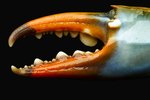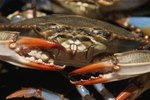
Crabs are members of the crustacean order, along with lobsters (Nephropidae), crayfish (Astacoidea) and all other marine insects. All crustaceans are members of the arthropod phylum. Arthropoda is the most diverse phylum on Earth and accounts for over 75 percent of all living things. Despite this diversity, crabs have a number of features that, when combined, distinguish them from similar creatures. Some creatures share a few of these characteristics, but no creature shares them all.
Decapod
Almost all crabs are decapods, meaning they have 10 legs. Horseshoe crabs (Chelicerata) have eight legs and are more closely related to spiders. In this regard, crabs have a similarity to lobsters and crayfish, but having 10 legs is a crucial distinction that separates crabs from centipedes (Chilopod), spiders (Araneae), millipedes (Diplopoda), ticks (Acarina) and scorpions (Dromopoda). The 10 legs of all decapods are situated in bilateral symmetry, with five on each side.
Hard Exoskeleton
The hard “crust” is a defining characteristic of crabs, lobsters and prawns. This exoskeleton distinguishes crustaceans from other arthropods, such as krill (Euphausiacea), but not terrestrial crustaceans such as woodlice and pill bugs (Armadillidiidae). The exoskeleton is a crucial feature of crustaceans, as it is one of the few means by which they avoid predation. In order for the vast majority of hard-shelled creatures to achieve mobility, they have jointed appendages. This is a common trait of arthropods, but is not shared by millipedes, centipedes and terrestrial insects, who have hard shells but unjointed legs.
Double Antennae
Most crabs have two pairs of antennae. This feature distinguishes them from non-decapod crustaceans, plus more distantly related arthropods, such as mites. Antennae are also a distinguishing feature between different crab species. While the vast majority of crabs have this distinguishing feature, the horseshoe crab does not.
Sideways Walking
The one feature that crabs have that no other related species have is the preference to walk sideways. While it might be easy to assume this trait is a defining ability, it is not, as most decapods crustaceans have the ability to walk sideways, but show no preference for doing so. Only the crab displays such a preference, despite its ability to walk in any direction.
Land and Water Breathing
Crabs share the most anatomical similarities with prawns and lobsters, but only crabs, as a species, are able to survive on land and in water. They achieve this through having gills and lungs. Not all crabs can survive on land, such as marine hermit crabs (Clibanarius), but many crab varieties, including the iconic blue land crab (Cardisoma guanhumi), can survive in both marine and terrestrial environments.
References
- The Department of Zoology at Miami University: Phylum Arthropoda: Subphylum Mandibulata: Class Crustacea
- West Virginia University: Arthropod Structure and Development
- University of Illinois: A Brief Overview of the Arthropods (Phylum Arthropoda)
- University of Texas School of Biological Sciences: Arthropod
- Northern Michigan University: Freshwater Crab Biology
- Smithsonian Marine Station and Fort Pierce: Cardisoma Guanhumi
Photo Credits
-
Jeffrey Hamilton/Photodisc/Getty Images
Writer Bio
Simon Foden has been a freelance writer and editor since 1999. He began his writing career after graduating with a Bachelors of Arts degree in music from Salford University. He has contributed to and written for various magazines including "K9 Magazine" and "Pet Friendly Magazine." He has also written for Dogmagazine.net.




